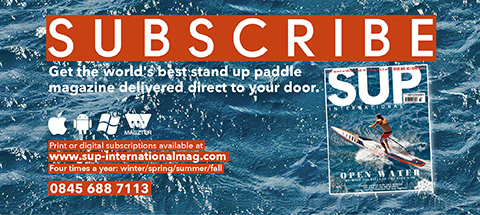SURF TECH –
BACKSIDE BASICS
With – Finn Mullen
Photo – Katie McAnena, Mikee Hamilton & Alan Bennett
Backside surfing on a SUP is very different to conventional backside prone surfing and challenging for most riders in the early stages. Even more so than frontside SUP surfing, paddle placement is crucial. Finn Mullen breaks down when and where to use your paddle and the basics of the art of backside riding on your SUP.
BACK PROBLEMS
I can remember my first backside wave on a SUP, it wasn’t pretty. I bit like an awkward first dance, my paddle and I found it hard to have any sort of movement that didn’t resemble the grace of a gorilla using chopsticks. Uncoordinated, I resorted to surfing switch stance, convinced that backside SUP surfing was for aliens or the uber-talented. It remained that way until I realized my switch stance surfing was just as bad and that if I kept on surfing in the one direction I would eventually run out of water somewhere between Iceland and Liverpool. The quest for enlightenment began.
Prone backside surfing has evolved to no longer be the poor relation to frontside and even an average prone surfer can appreciate how easy it is to load the rail with your heels. The problem with SUPs is that with thicker rails the degree of force required to load that rail is greater, fortunately though, we have the paddle. Ah yes the paddle, in my early stages of backhand SUP surfing the destructive trait of letting go of the paddle with one hand would creep in and to this day it is still a common sight I see amongst other aspiring students of the art. While great for making you feel like you are some sort of hybrid between Kelly Slater and Kai Lenny as you race down the line, it’s a bit like riding a rocking horse, feels great but doesn’t actually get you anywhere.
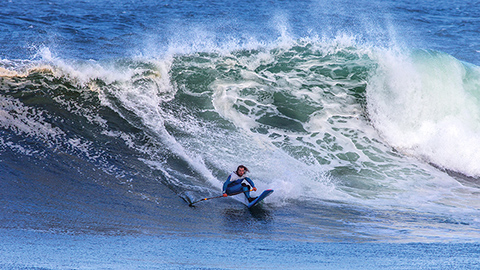
Backside bottom turns allow you to really compress and let all that heel pressure commit to the rails and fins. Finn Mullen digs in at East Strand, Portrush, Northern Ireland. Photo Alan Bennett.
ANALYSE
Let’s analyse it further; backside prone surfing is all about opening the shoulders to the turn, so of course there is a natural tendency to take a hand off the paddle and open out the arms to feel that same technique to drive a SUP board through a turn. Open shoulders alone cannot turn a SUP, but planting our paddle in the water (with both hands on it!) and using it as a pivot point and lever for our body will.
Having established the why, let’s look at the how. Not to sell the fine medium of print short, but one of the best tools to help you grab the basics of the required paddle movements is watching videos of the pros at work.
‘CROSS BOW’
There’s plenty of homework available for viewing online and amongst the myriad of pro styles you will see a common move, the ‘cross bow’ turn. Here the paddle switches from the inside to outside rail – drawing it across the bow of the board – hence the name. It’s basic physics that switching momentum like this will produce a desired turning motion but there is other important principles and stages. For all the challenges of backside surfing there is one major advantage and that is we can exert more pressure on our heels than our toes so potentially there is a lot of force we can harness.
Good surfing always starts with a good bottom turn and that relies on body weight being exerted on the inside rail and fin. By planting our paddle to the inside rail and inside of the turn for the start of the ‘cross bow’ we can begin to shift that body weight inwards. Whilst it may look like we are leaning over, what we are actually trying to achieve is pressure on that inside rail and fin. Understand that and you will understand why it’s not so much the lean, but legs staying square to the board that is the goal in your stance and key to applying maximum pressure. Stay low and compressed to keep balanced and the pressure on.
Having established good entry to the ‘cross bow’ turn we can now focus on the top turn. From your compressed bottom turn, the goal is now to unleash that energy. The compression gives you room to ‘spring’ your body out. If we stand tall throughout the move there’s no room for our body to adjust.
All that extra leverage of our heels on our backside gives us more power and speed to place the turn where we want. The higher up the wave face you make the turn, the more speed, redirection and risk increase. Go too late and you’ll fall out the back, go too early and you will lose connection with the power and flow of the wave – aim for the top half of the wave is a good start.
“ Open shoulders alone cannot turn a SUP, but planting our paddle in the water (with both hands on it!) and using it as a pivot point and lever for our body will ”
Keeping eyes on the lip, find your spot to turn and begin to lift your front shoulder allowing the nose to rise and freeing your paddle of the water. Twist your upper body and move the paddle across the board. Keep the dead time of transition of the paddle from the inside rail to the outside rail to a minimum to make the move as dynamic as possible. When you plant the paddle again on the toeside / outside rail, remember this is now the pivot point of the turn, so keep it a reasonable distance away from the rail to give some room to arc the radius of the turn around. As the turn deepens, the shoulders have come right round, with body weight now on the paddle and opposite rail. Complete the turn by shifting pressure to the leading leg and foot, releasing the tail for some style. As the turn starts to end, focus on the recovery, keeping your body neutral and relaxed, ready to plan the next move and staying with the power of the wave.
Key points are lay the foundations of the move with a powerful bottom turn, drive the turn with your shoulders but have your paddle as the lever to exert the power needed to engage those thick SUP rails.
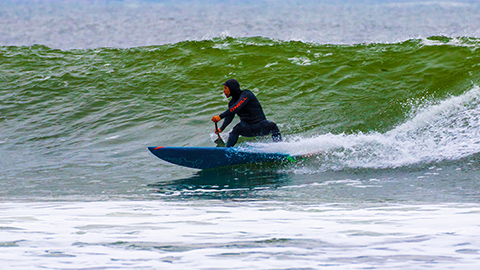
A good bottom turn is the best place to start for good surfing, backside or frontside. Feet apart, weight over the inside rail using the paddle on the inside of the turn for balance with head up and eyes on the section ahead, judging position for the top turn. Photo Mikee Hamilton.
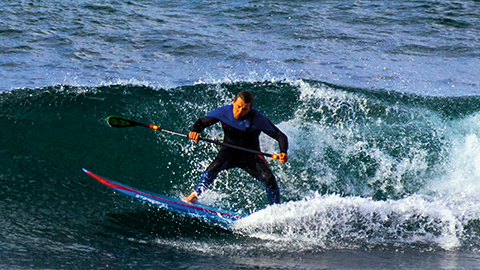
Climbing the face to top turn, weight has been taken off the inside rail and a strong wide stance taken up with hands over feet and paddle parallel to board. To stay in the power pocket, we’re aiming to transition in a critical part of the wave. It’s breaking out of vision just behind you when you’re on your backhand, so it’s important to be in a strong stance to deal with any unexpected forces you feel but can’t see and react quickly to. Photo Katie McAnena.
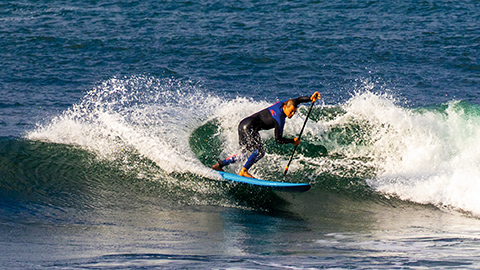
The paddle is now ‘planted’ into the face allowing us to accentuate the turn by leaning the upper half of our body over the paddle giving room and balance to extend the back leg, pushing the tail out for some spray. Photo Katie McAnena.
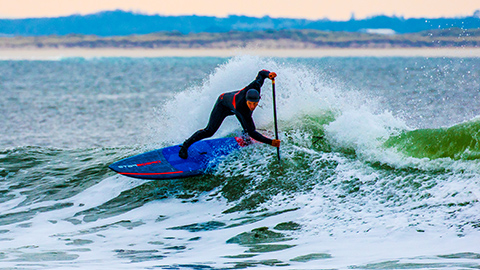
A good wide grip on your paddle allows you to create space and strength for the rest of your body to extend and push away from. Photo Mikee Hamilton.
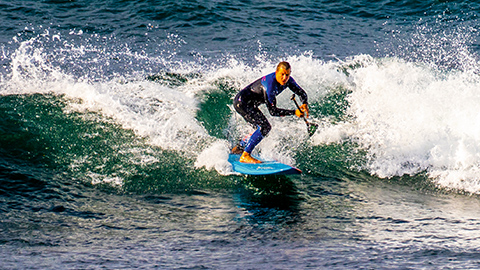
In transition from top to bottom turn and switching the paddle, try to keep your body well aligned and over the midpoints of the board. Head up, knees bent and broad stance gives a stable base to work from. Photo Katie McAnena.
LIP WORK
So far we’ve looked at the most popular and fundamental SUP backside turn, but it’s not the only move we will have to perform and correct paddle placement still plays an important role in the other moves.
Let’s consider a face with a crumbling or pitching lip, there’s sometimes not time to engage the ‘cross bow’ turn. We need to be able to adapt and understand how the placement of the paddle can weight and unweight the board at appropriate times. Moving down the line with the paddle on the heelside / inside rail limits our trim if we aren’t going to commit to a ‘cross bow’ turn so remember there is a time for keeping it to your toeside / outside rail also – fast waves or lip work for example. For floaters if we put the paddle to the toeside rail and down we can commit all our weight to the paddle and allow the board to unweight and ‘float’ and us to recover as we use the paddle to ‘crutch’ onto as we come back down with the whitewater. If it’s a crumbling lip of a weak section we can raise our shoulders and the paddle up to generate lift and increase the dynamics on offer.
Faced with a hollow section we have the one and only time it’s legit to possibly drop a hand off the paddle to squeeze into a liquid tunnel.
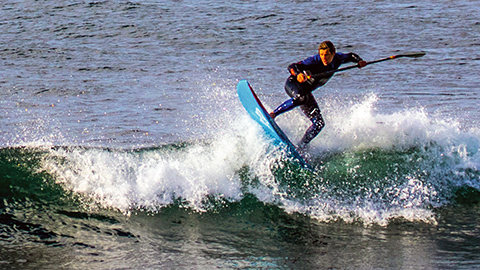
With a small, relatively powerless wave and oncoming foamy section we can raise the paddle up to help lift the board and generate movement and speed. Photo Katie McAnena.
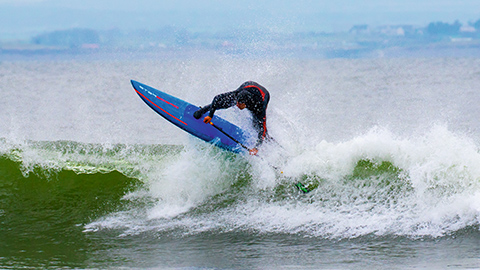
Paddle on the outside rail for a backside floater. Using it in this position allows us to unweight the board and ‘float’ up and over the lip and help us recover as we come back down. Photo Mikee Hamilton.
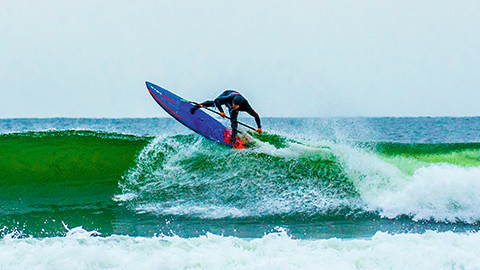
A fast section and pitching lip means there’s not always time to switch hands or transition the paddle across your body. In this case, the paddle has been taken directly from the heelside / inside rail’s bottom turn point to the centreline of the board for a quick hit on the falling lip line. By keeping paddle and body centred over the board you maintain the balance to ride out. Note the accentuated leg spread, rear foot and weight well back on the tail pad to keep the nose up and clear but the front foot well forward to counterbalance on landing. Photo Mikee Hamilton.
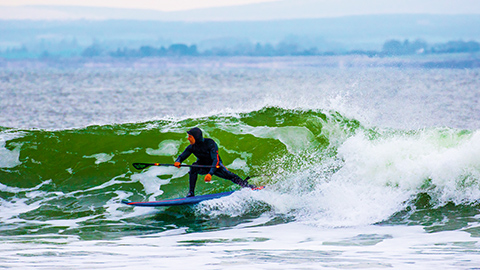
Possibly the only time it’s acceptable to drop a hand off your paddle – if you see an opportunity for some shade and a cover up, don’t be afraid to take a hand off to free up your body and allow you to crouch low into a classic surfer stance with back leg bent and weight on that forward foot to drive you through to a clean exit. Photo Mikee Hamilton.
FUNDAMENTALS
To build a wall you need bricks, to build the basics of backside SUP surfing there is a few fundamentals you can put in place to help your progress. Paddle size, both length and blade area, is an area for consideration. A shorter paddle with a smaller blade area is easier to plant and withdraw from the water and to handle in paddle transitions. If you do experiment with changes to your paddle height or blade size, make it gradual and in small increments to make the technique change comfortable.
The way you surf on your backhand with increased rail and fin pressure from your heels can make your board feel entirely different to how it surfs on your forehand. If you’re struggling for drive to cope with the increased pressure, consider a quad setup with its increased fin area to load against or the addition of a ‘nubster’ / trailer fin if you already have quads. If you have a thruster setup, try moving your centre fin rearward, but not so much that the board is too stiff on the top turn.
If you are struggling with paddle transitions from heelside to toeside rail, then try some flat water drills to gain confidence. There is a lot you can gain from either practicing with the board at rest or in motion. You don’t need a wave to get moving, set the board gliding after a few strokes on flat water and practice switching the paddle from side to side. On land you can practice with your sup board mounted on a bench etc. or even better, practice with a cruiser skateboard / landboard where the arc of turns can be well simulated.
If you find it hard getting low and compressed during your bottom turns, think about some drills on land or flat water whereby you crouch and touch the rails to exaggerate the movement and get your body used to the mechanics involved, making sure you do this only enough to not form any bad habits. Rail grabbing should only be used in your actual surfing for the very thickest of barrels! Squats are another useful exercise to carry out on your board in flat water. Standing in your surf stance, squat up and down to get used to the dynamics you should be committing to while bottom turning for example.
Backside surfing is challenging but ultimately very rewarding when performed correctly. The extra torque you can unleash with your heels and proper use of the paddle can make for a very stylish flow and highly functional ride. Don’t be disheartened if you feel frustrated at first. I started with practically no backside skills on my SUP, but by accepting that prone surfing technique had little crossover and studying and practicing the few core points of paddle use I began to progress. Stills or video analysis of your technique is very helpful for self-coaching and identifying weak points. Aim to get the shots or footage that people will watch when it comes their turn to learn backside basics! SUP


